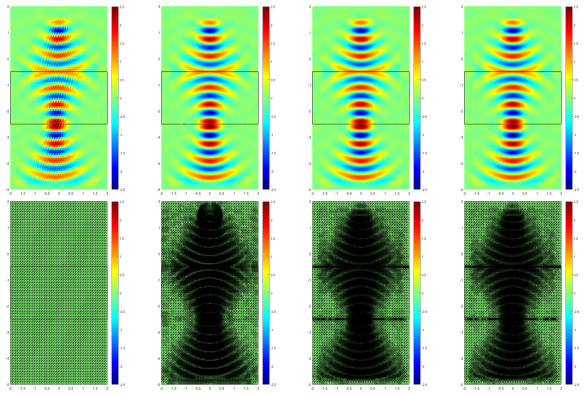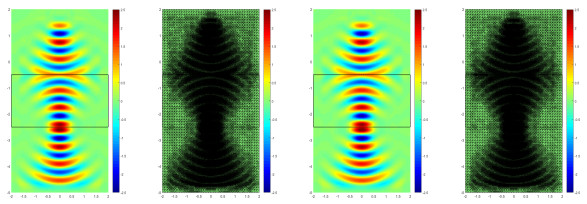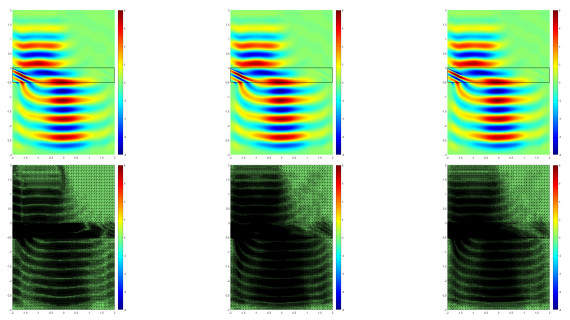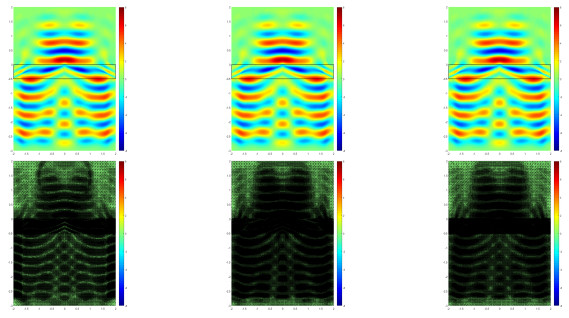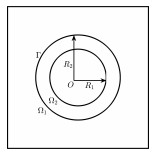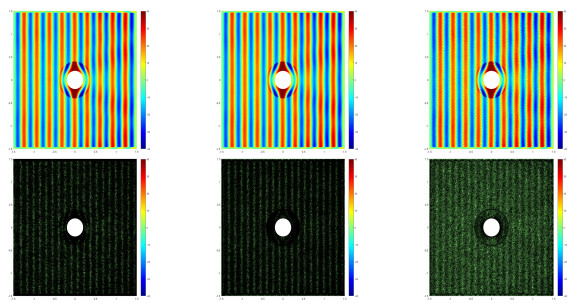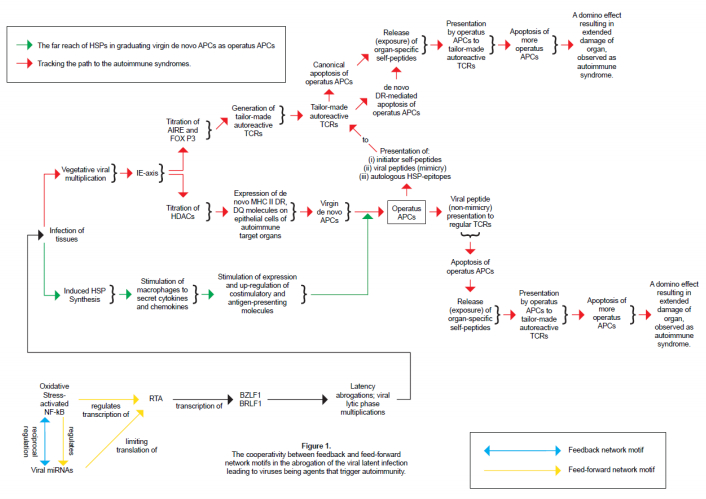To happen, autoimmunity in man requires triggering by environmental factors: the viruses and cellular stress, in genetically primed individuals. The viruses and stress are operatives in this scene as stimuli for the activation of the transcription factor (TF), NF-ΚB. NF-ΚB is unusually activated: the viral activation occurs via serine residues-phosphorylation by IKKβ and IKKε, while the activation by oxidative stress occurs via tyrosine phosphorylation of IΚBα. The phosphorylation of particular amino acid residues of a given protein molecule modulates that protein’s polymorphic conformations, appropriately. For a TF, a given conformation influences its choice of cognate DNA sequence recognition as well as its interactions with neighboring molecules. The TF NF-ΚB performs a battery of regulatory functions. Because it is variously phosphorylated as seen above this implies that NF-ΚB is capable of assuming a multitude of polymorphic conformations that we refer to as “derivative isoforms”. Thus the virus activation of NF-ΚB occurring by phosphorylation at serines S536 and S468 is observed to generate the isoforms with the potential to activate the transcription of viral latency genes, hereby installing a latent infection. But oxidative stress activation of NF-ΚB occurs via phosphorylation of Tyr42 of IΚBα and this yields isoforms that activate the transcription of replication and transcription activator (RTA), the master lytic switch, which thereby abrogates the latency. The steps involved are that the stress-activated NF-ΚB and the viral miRNAs conjoin in a regulatory circuitry identified as feedback and feed-forward network motifs that co-accomplish the switching on of RTA which in turn activates the transcription of the immediate early genes BZLF1 and BRLF1. These two latter genes together mobilize the expression of the set of lytic genes, resulting in a lytic cascade and consequentially set in trend the viral journey to the triggering of autoimmunity (Figure 1).
1.
Introduction
In this paper, we consider the following two-dimensional time harmonic Maxwell's equations
where Ω⊂R2 is a bounded domain with Lipschitz boundary ∂Ω, E=[E1,E2]t denotes electric field and F=[F1,F2]t∈[L2(Ω)]2 represents the given wave source term, where [L2(Ω)]2 is denoted as the two-dimensional vector space of square integrable functions. The parameters μ and ε are the permeability and permittivity of the material medium, which may be functions of position. And k is the wavenumber. The curl ∇× of v=[vi]di=1 is defined differently depending on the space dimension d. For d=1, the curl of a scalar v is defined as the vector ∇×v=[∂yv1,−∂xv1]. For d=2, it is the number ∇×v=∂xv2−∂yv1.
Solutions of many problems of interest require computation of phenomena occurring in a physical domain of infinite extent. In such an infinite domain, electromagnetic sources are all considered to be at the origin, and to scatter energy to infinity. A condition is required to prevent the nonphysical inverse process, where energy is transferred by radiation from infinity to the origin, and ensure uniqueness of the solution in an infinite domain. For the two-dimensional case, the following condition, known as the Silver-Müller radiation condition [5], must be satisfied
The numerical approximations of the Maxwell's equations have been extensively investigated in the last many years, such as finite element method (FEM) [6,7,15,18,23,36], finite difference time domain method (FDTD) [14,30], interior penalty discontinuous Galerkin method (IPDG) [17], hybridizable discontinuous Galerkin method (HDG) [27], nodal discontinuous Galerkin method (NDG) [22] and multigrid method (MG) [11], etc. In recent years, metamaterials as a new type of material have attracted people's attention because of their potential applications in many fields [14,28], such as cloaking devices [2,12,24], sub-wavelength imaging and perfect lens. We mention in passing some related mathematical research on metamaterials in the literature [1,4,20,21], and some related finite element methods designed for simulating the electromagnetic wave in metamaterlals [33,34,35]. The advantage of adaptive finite element method in metamaterials, which will be considered in this paper, is to make possible, with reasonable computational cost, the local mesh adjustment of the computational domain according to a-posteriori error estimator.
The adaptive method can improve the efficiency of electromagnetic field calculation, and it is simple and and accurate [6,7,23]. In this paper, we develop the adaptive finite element method of Maxwell's equation in metamaterials. Because many electromagnetic problems are actually interface problems, we need to deal with them carefully. Some parts of the interface problems do not need to be refined near the interface, but they are still refined by using the usual indicators. So the more efficient a-posteriori error estimator should be considered without regard to the particularity of the examples and make the meshes match the images of the numerical solution better, which is the purpose of this article. In view of such problems, the recovery technique is used in each sub-area and the corresponding error is calculated. Errors of all sub-areas constitute errors of the domain of interest to guide the grid refinement.
The rest of this paper is organized as follows. In Section 2, we introduce the finite element scheme for the Maxwell's equations. A-posteriori error estimators are proposed, which include two types: one is the residual-based and the other is the recovery-based in Section 3. Afterwards in Section 4, several numerical examples are presented to compare the realization effect of the different posteriori error indicators. In Section 5, we give a conclusion.
2.
Finite element scheme
Let L2(Ω) be the Hilbert space of square integrable functions on Ω equipped with the standard L2-norm: ||w||=√(w,w), where (⋅,⋅) is standard L2-inner product. Consider the following Hilbert space
and the subspace
equipped with the norm
where n is the unit outward normal vector to ∂Ω.
The Berenger PML [3] is applied to approximate the Silver-Müller radiation condition with the perfect electric conductor (PEC) boundary conditions
The variational formulation of Eq.(1) reads: Given F∈[L2(Ω)]2, find E∈H0(curl;Ω) such that
where
Let Th={K} be a regular triangle partition of the domain Ω with mesh size h, define the lowest order edge elements space [25]
A basis for Vh is given by the set of Nédélec's shape functions {ϕi}nei=1 with ne the number of triangle edges in the mesh, the simple formula for local shape functions is defined as
for any triangle K∈Th, E=[vi,vj]⊂¯K with vertices {vi=(xi,yi)}3i=1, and associated with linear Lagrangian basis functions {λi}3i=1, where the explicit expressions for the basis λi of the triangle K is given by
with cyclic permutation of the indices {i,j,k} over {1,2,3} and |K| is the area of K. It can be shown that edge finite elements guarantee the continuity of the tangential component across faces shared by adjacent triangles; they thus fit the continuity properties of the electric field.
With the choice of discrete space Vh, the curl-conforming finite element scheme of Eq.(4) takes the form as follows: Given F∈[L2(Ω)]2, seek Eh∈Vh such that
3.
A-posteriori error estimations
Having computed a finite element solution, it is possible to obtain a-posteriori error estimations. These estimations accomplish two main goals. Firstly, they are able to quantify the actual error numerically. Secondly, they can be used to perform the adaptive mesh refinement, which solves the problem iteratively. The method uses a-posteriori error estimators to indicate where errors are particularly high, and more mesh intervals are then placed in those locations. This process
can be repeated until a satisfactory error tolerance or result is reached. In this section, we propose a-posteriori error estimations including not only a residual type but also a recovery type. A Dörfler marking strategy [13] is used in the adaptive process.
3.1. The residual-based a-posteriori error estimation
The residual type a-posteriori error estimator ηr0Kl [15] for the element Kl is defined as
where E denotes the set of all interior edges, hKl=|Kl|1/2 is the the diameter of Kl, and the local contributions R1Kl,R2Kl and J1E,J2E are defined, respectively, as
and
where [F⋅v]E:=F⋅v|Km−F⋅v|Kn on the edge E for E=Km∩Kn, Km,Kn∈Th.
3.2. The recovery-based a-posteriori error estimations
The recovery type a-posteriori error estimators ηr1Kl [23] and ηr2Kl are considered, respectively, as
and
for Kl∈Th, here R denotes the recovery operator. The specific recovery algorithm see the Algorithm 1.
Remark 1. Recovery operator can be built in a variety of ways such as gradient recovery [19,26,37], functional recovery [29], flux recovery [8,9,10,31] and so on. Two quantities related to μ−1∇×E and εE are recovered in the respective H(curl)-and H(Div)-conforming finite element spaces in [9,10]. It is different that we take average of flux to construct the flux recovery operator, which is easy to implement with superconvergence.
Theorem 3.1. Assume that the domain Ω is covered by a triangular mesh formed by parallelograms, and under the assumption [23,Lemma 2.6]:
(1) Assume that |μ−1|<C1, for any function u=(u1,u2)T∈(W3,∞(Ω))2 and any parallelogram center xe, we have
(2) Assume that |εi|<C2(i=1,2,3,4) with ε=[ε1,ε2;ε3,ε4], for E∈(W2,∞(Ω))2 and h is enough small with any parallelogram center xe, we have
(3) Under the assumption of (1) and (2) above, E and Eh satisfy Eqs.(4) and (6), respectively. If E∈(W3,∞(Ω))2 and h is enough small, then we have
Remark 2. The proof of Theorem 3.1 is similar to the reference of [23,Lemma 2.7], [16,Theorem 3.3] and [23,Theorem 2.2].
4.
Numerical examples
This section is devoted to numerical examples to illustrate the efficiency and reliability of the proposed a-posteriori error indicators. The wave source term is given by F=k2Pexp(ikd⋅x)q(x), where i=√−1 is the imaginary unit. For simplicity, we use the Ndof and I to denote the number of degrees of freedom and the identity matrix, respectively.
Example 4.1. Let Ω=[−1,1]×[−1,1] and take the coefficients as follows
We choose the analytic solution
and compute F accordingly.
The Example 4.1 is aimed to test the convergence result stated in Theorem 3.1. Clearly, the results shown in Table 1 are consistent with Theorem 3.1.
Example 4.2. Let Ω be the rectangular domain [−2,2]×[−5,2], the parameters μ and ε are taken, respectively, as
and
where the negative index metamaterial medium area Ω1=[−2,2]×[−2.5,−0.5]. We choose k=10,P=[1,0]t,d=[0,1]t and q(x)=1−4(x2+(y−1.45)2) in the ball with a center (0,1.45) of radius 1/2 and q(x)=0 outside. In our simulation, we choose a uniform mesh with h=0.1 and use a PML with 5 cells in thickness around the rectangular domain.
Example 4.2 simulates the backward wave propagation phenomenon illustrated in Fig. 1, which is based on the three types a-posteriori error indicators mentioned above. It can see that wave propagates as usual before it enters the metamaterial region. Once the wave enters into the metamaterial, wave propagates backward inside the metamaterial slab. And that wave propagates as usual again when leaves the metamaterial slab.
From the point of view of suitability between the grid and the numerical solution, it can be seen that the residual type is better than the others in Fig. 1. From the numerical solution of the images, some parts of the horizontal interfaces between the two media do not need to be refined, but in fact, these places are still refined when using the recovery a-posteriori error indicators.
Thus according to two horizontal interfaces formed between the media, we divide the whole area into three sub-areas, and the recovery type a-posteriori error of the whole area is consisted of these sub-areas, which are shown in Fig. 2. Compared with the direct recovery type a-posteriori error of the whole area in Fig. 1, adaptive meshes by using the recovery type a-posteriori error of the whole area consisted of the error for these sub-areas perform better on the interfaces during the refinement process, which achieves the expected effect.
Remark 3. In Example 4.3-4.6, we also first consider the three types a posteriori error indicators mentioned above on the whole area and then consider that according to the number of interfaces n formed between the media, the entire area can be divided into n+1 sub-areas, which each sub-area is independent and parallel computing can be considered, the recovery type a posteriori error of the whole area is consisted of the error for these sub-areas.
Example 4.3. Let Ω=[−2,2]×[−3,2] be a rectangular domain with k=10,P=[1,0]t,d=[0,1]t and q(x)=erfc(5((x−x0)2+(y−y0)2−1))/2, where erfc(x)=2√π∫∞xexp(−t2)dt. The parameters μ and ε are defined as follows
and
which can be easily derived according to the theory of article [36] while the wave propagates along the y-axis. The constant mp is called "moving parameter" and the symbol "∗" denotes as the symmetric part of the matrix. In our simulation, we choose a uniform mesh with h=0.1 and use a PML with 5 cells in thickness around the rectangular domain.
In Example 4.3, the moving medium area is fixed in Ω1=[−2,2]×[−0.5,0], which can be denoted as the union of Ω2=[−2,0]×[−0.5,0] and Ω3=[0,2]×[−0.5,0]. We achieve the different moving effects by the different choices of the center point (x0,y0) and the parameter mp.
Firstly, we choose the center point (x0,y0)=(1,1.45) with mp=2 for the domain Ω1, i.e., the wave source is fixed in the upper right. Clearly, we can see that the wave moves from right to left after wave passes the moving medium area shown in Figs. 4 and 5.
Then, the center point x0=(x0,y0) are chosen as (−1,1.45) with mp=−2 for the domain Ω1, i.e., the wave source is fixed in the upper left. Obviously, we can see that the wave moves from left to right after wave passes the moving medium area shown in Figs. 6 and 7.
Finally, the constant mp is taken as 2 for domain Ω2 and −2 for domain Ω3 with the center point x0=(0,1.45), i.e., the wave source is fixed in the upper middle. Evidently, we can see that the wave moves from the middle to left and right after wave passes the moving medium area shown in Figs. 8 and 9.
Overall, it can be seen that the recovery type a-posteriori error indicators perform better.
For Example 4.4-4.5, we consider the square domain Ω=[−1.5,1.5]×[−1.5,1.5] with k=20,P=[0,1]t,d=[−1,0]t,q(x)=1 and use a PML with 1/60 of the region in thickness.
Example 4.4. The parameters μ and ε are taken, respectively, as
and
where m=θ0rR2−R1. Here, we choose the initial mesh with 167744 Ndof and take R1=0.2, R2=2R1, θ0=π2 in the simulation.
In Example 4.4, we simulate the cylindrical rotation cloak. To see how wave propagates in the rotator, we plot the electric fields E in Figs. 10 and 11. Clearly, it can be observed that the wave gets distorted in the metamaterial region and note that the parameter θ0 determines the degree of distortion of the wave. Although the residual type a-posteriori error estimator achieves the rotation effect, the corresponding grid does not match the graphs of the numerical solution at all. In contrast, the recovery type a-posteriori error indicators are always good and meshes are more refined in the metamaterial region.
Example 4.5. We consider the parameters
and
where the constants are denoted, respectively, as,
In our simulation, the parameters a, b and c are taken as 0.2, 0.4 and 0.6, respectively. There is 167744 Ndof in the initial mesh.
Example 4.5 simulates the electromagnetic concentration effect, which are shown in Figs. 12 and 13. As in the previous example, although the residual type a-posteriori error estimator achieves the concentration effect, the pattern of the corresponding grid is not matched with the graph of the numerical solution. The advantage of recovery type a-posteriori errors is prominent again.
Example 4.6. Let Ω be the part of the square domain [−1.5,1.5]×[−1.5,1.5] outside the circle centered at origin with radius R1. The computational areas Ω1 and Ω2 (Γ=Ω1∩Ω2) are shown in Fig. 14. Here, we take R1=0.2, R2=2R1 and the initial mesh with 20287 Ndof. We choose k=20,P=[0,1]t,d=[−1,0]t and q(x)=1. The parameters μ and ε are given as follows
and
In Example 4.6, the colaking simulation is displayed in Figs. 15 and 16. It is obvious that the recovery-based a-posteriori error estimation ηr1Kl works well and the implementation is faster. Note that neither the permeability μ−1 nor the permittivity ε belongs to L∞(Ω), which is not under assumptions in Theorem 3.1. In spite of this, recovery-based a-posteriori error estimation ηr2Kl still works for this example.
Remark 4. The relationship between the direction of wave source and the position of metamaterial plays a very important role in the actual simulation.
5.
Conclusions
In this paper, we used adaptive edge element method for the time-harmonic Maxwell's equation, which was not only based on the residual type a-posteriori estimation, but also based on the recovery type. And we presented the numerical examples to illustrate the reliability and efficiency of the proposed a-posteriori error estimations. By adding the different wave source terms, the results were similar to those obtained by the time domain Maxwell's equations simulations [18,36]. Through the results of these examples, it can see that the recovery type a-posteriori error indicator deserves to be considered and recommended on the each sub-area.
Acknowledgments
Wang's research was supported by Hunan Provincial Innovation Foundation for Postgraduate(CX20190464). Yang's research was supported by NSFC Projects 11771371, Key Project of Hunan Education Department, China 18A056 and Project of Scientific Research Fund of Hunan Provincial Science and Technology Department(No: 2018WK4006). Huang's reserach was supported by NSFC Projects 11971410.









 DownLoad:
DownLoad:
